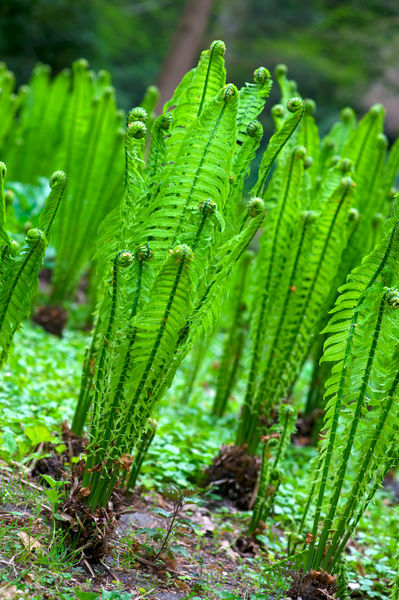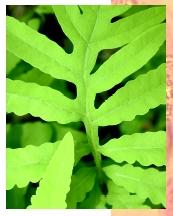Pteridophytes

Pteridophtyes are a phylum of plants. They are the vascular plants (those having xylem and phloem tissues) that reproduce by releasing spores rather than seeds, and they include the highly diverse true ferns and other graceful, primarily forest-dwelling plants. There are about eleven thousand different species of pteridophytes, making them the most diverse land plants after the flowering plants (angiosperms). Pteridophytes may represent the closest living relatives (sister group) to the seed plants. (Seed plants include the angiosperms, the conifers, and a smaller assortment of other plants.)
As in seed plants, the greatest diversity of pteridophytes is found in the tropics, with only about six hundred species adapted for life in temperate climates. Species living today are relics of ancient lineages that once dominated

Pteridophytes range greatly in size. There are tiny floating ferns used as "green fertilizer" in rice paddies because they partner with bacteria that pull nitrogen from the air and "fix" it in chemical compounds that other plants can use. In some tropical forests, the largest plants are tree ferns that can be up to 30 meters (100 feet) tall and have huge spreading leaves up to 4.5 meters (15 feet) in length. Pteridophytes also show a transition from simple to complex leaves. Some pteridophyte groups, including the club mosses and horsetails (classes Lycopodiopsida and Equisetopsida), have simple microphyllous leaves, featuring a single, unbranched vein and modest vascular supplies that do not cause breaks or gaps in the stem vasculature. The true ferns (class Filicopsida), however, have larger, more complex macrophyllous leaves whose veins are usually extensively branched, placing such large demands on the plant's vasculature that distinctive gaps form in the xylem and phloem of the stem.
All pteridophytes have a true alternation of generations, in which a dominant sporophyte generation produces spores through meiosis , and a free-living gametophyte generation forms gametes (egg and sperm) by mitosis . Ferns can be used to illustrate the life cycle stages common to all pteridophytes. Diploid (2n) fern sporophytes are familiar to most people and are often found as quiet accompaniments in floral arrangements. When mature, the undersides of fern leaves produce clusters of capsular structures called sporangia, within which meiosis forms the haploid (n) spores. These spores are released from the sporangia, often when dry wind currents cause the active snapping of the capsules, lofting the spores into the air.
Spores that are wind-borne to shady, moist habitats germinate and yield multicellular, but microscopic, gametophytes, the sexual stage of the life cycle. These short-lived, delicate plants mature and produce egg-forming archegonia and sperm-producing antheridia. When water is present, multi-flagellated sperm swim from mature antheridia, are chemically attracted to the necks of the archegonia, and fertilize the eggs. Although frequently bisexual (hermaphroditic), in most cases the sperm produced by a gametophyte cannot successfully fertilize its own eggs and must swim to archegonia on neighboring, genetically different gametophytes. The diploid zygotes , produced by the fusion of haploid egg and sperm, divide mitotically and differentiate into mature sporophytes, completing the life cycle.
Although most pteridophytes are homosporous (produce spores that are all the same size), a few groups are heterosporous with large megaspores and small microspores. The megaspores produce megagametophytes that only form eggs, and microspores only produce microgametophytes and sperm. Heterospory evolved independently in several groups of vascular plants, including all members of the orders Selaginellales and Isoëtales and those in a few fern groups (the families Marsileaceae and Salviniaceae of the class Filicopsida). The most successful origin of heterospory ultimately resulted in the great diversity of seed plants.
No pteridophytes are cultivated as crop plants, but the leaf buds ("fiddleheads") of some ferns are commercially harvested and canned or frozen. Fern leaves used in floral arrangements are a major industry in Florida, and in some cultures tree fern stems are used to make elegant, naturally sculpted bowls. The contrasting colors of the vascular tissue in the stems and leaf bases of these plants create complex and pleasing designs. In the past, club moss spores provided the powder used to coat rubber gloves and prophylactics, and photographers used masses of these same spores as flash powder, since they could be easily and quickly ignited.
SEE ALSO Alternation OF Generations ; Angiosperms ; Bryophytes ; Nitrogen Fixation ; Plant ; Reproduction IN Plants ; Seedless Vascular Plants
Christopher Haufler
Bibliography
Jones, David. Encyclopaedia of Ferns. Melbourne, Australia: Lothian Publishing Co., 1987.
Raven, Peter H., Ray F. Evert, and Susan E. Eichhorn. Biology of Plants, 6th ed. New York: W. H. Freeman and Company, 1999.
Tyron, Rolla, and Alice Tyron. Ferns and Allied Plants. New York: Springer-Verlag, 1982.
CLASSIFICATION OF THE PTERIDOPHYTES
Phylum Pteridophyta
Class Lycopodiopsida
Order Lycopodiales, the club mosses* and ground pines, approximately 400 species
Order Selaginellales, the spike mosses*, approximately 450 species
Order Isoetales, the quillworts, approximately 130 species
Class Equisetopsida, the horsetails or scouring rushes*, 15 species
Class Psilotopsida, the wisk ferns, approximately 12 species
Class Filicopsida, the true ferns, approximately 10,000 species
* The common names "mosses" and "rushes" applied to these species do not mean that these groups are related to the mosses and rushes, any more than a pineapple is related to pines or a breadfruit has some affinity to wheat. True mosses are nonvascular plants whose most commonly recognized life form is a gametophyte, and true rushes are grasslike flowering plants. Instead, these common names indicate that the club "mosses" and spike "mosses" are often small plants that hug the ground, and scouring "rushes" have long, grasslike stems.
Comment about this article, ask questions, or add new information about this topic: